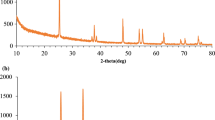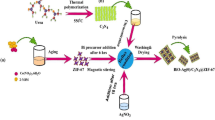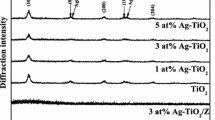Abstract
Background
Most dyes have aromatic rings in their structures, which make them highly toxic for human being and aquatic life. Heterogeneous photodegradation using TiO2 nanoparticles is one of the most applied methods used for dye removal. The wide band gap of TiO2 nanoparticles disables its use of the visible light and thus the vast potential of sunlight. To overcome this deficiency, Ag doped TiO2 nanoparticles were loaded on Fe-ZSM-5.
Methods
Fe-ZSM-5@TiO2-Ag photocatalyst was synthesized through sol-gel and hydrothermal methods to remove hazardous Reactive Red 195 (RR 195) from aqueous solution.
Results
Pure phase of Fe-ZSM-5@TiO2-Ag with specific surface area of 332 m2/g was successfully synthesized. Formation of Ti-O-Ag functional group in the photocatalyst structure confirmed the nanocomposite form of the product. SEM and TEM images portrayed the synthesized zeolite and photocatalyst NPs in a size range of ≤100 nm with homogenous distribution of Ag doped TiO2 on Fe-ZSM-5 surface. The band-gap energy of Fe-ZSM-5@TiO2-Ag was calculated 1.97 eV at λ = 630 nm. Photocatalytic activity of the photocatalyst under natural sunlight was investigated through photodecomposition of RR 195 in an aqueous solution. The dye photodecomposition of about 98% was achieved at photocatalyst concentration of 400 mg/L, pH of 3, and dye concentration of 50 mg/L at ambient temperature after 120 min under sunlight using 0.5 ml of TiO2 and silver ammonium nitrate. The photocatalyst reusability was found significant after 5 frequent cycles.
Conclusion
The novel Ag-doped TiO2-Fe-ZSM-5 nanocomposite with sunlight sensitivity can be a promising candidate to purify wastewater containing organic pollutants.















Similar content being viewed by others
References
Hou H, Zhou R, Wu P, Wu L. Removal of Congo red dye from aqueous solution with hydroxyapatite/chitosan composite. Chem Eng J. 2012;211-212:336–42.
Fouladi Fard R, Sar MEK, Fahiminia M, Mirzaei N, Yousefi N, Mansoorian HJ, et al. Efficiency of multi walled carbon nanotubes for removing direct blue 71 from aqueous solutions. Eurasian J Anal Chem. 2018;13.
Jirasripongpun K, Nasanit R, Niruntasook J, Chotikasatian B. Decolorization and degradation of CI reactive red 195 by Enterobacter sp. Sci Technol Asia. 2007:6–11.
Elwakeel KZ, Rekaby M. Efficient removal of reactive black 5 from aqueous media using glycidyl methacrylate resin modified with tetraethelenepentamine. J Hazard Mater. 2011;188:10–8.
He X, Male KB, Nesterenko PN, Brabazon D, Paull B, Luong JH. Adsorption and desorption of methylene blue on porous carbon monoliths and nanocrystalline cellulose. ACS Appl Mater Interfaces. 2013;5:8796–804.
Dalvand A, Nabizadeh R, Reza Ganjali M, Khoobi M, Nazmara S, Hossein Mahvi A. Modeling of reactive blue 19 azo dye removal from colored textile wastewater using L-arginine-functionalized Fe3O4 nanoparticles: optimization, reusability, kinetic and equilibrium studies. J Magn Magn Mater. 2016;404:179–89.
Ashrafi SD, Kamani H, Soheil Arezomand H, Yousefi N, Mahvi AH. Optimization and modeling of process variables for adsorption of basic blue 41 on NaOH-modified rice husk using response surface methodology. Desalin Water Treat. 2016;57:14051–9.
Kamranifar M, Khodadadi M, Samiei V, Dehdashti B, Noori Sepehr M, Rafati L, et al. Comparison the removal of reactive red 195 dye using powder and ash of barberry stem as a low cost adsorbent from aqueous solutions: isotherm and kinetic study. J Mol Liq. 2018;255:572–7.
Ashrafi SD, Rezaei S, Forootanfar H, Mahvi AH, Faramarzi MA. The enzymatic decolorization and detoxification of synthetic dyes by the laccase from a soil-isolated ascomycete, Paraconiothyrium variabile. Int Biodeterior Biodegrad. 2013;85:173–81.
Kamani H, Safari GH, Asgari G, Ashrafi SD. Data on modeling of enzymatic elimination of direct red 81 using response surface methodology. Data Brief. 2018;18:80–6.
Mehrabian F, Kamani H, Safari GH, Asgari G, Ashrafi SD. Direct blue 71 removal from aqueous solution by laccase-mediated system; a dataset. Data Brief. 2018;19:437–43.
Bali U, Çatalkaya E, Şengül F. Photodegradation of reactive black 5, direct red 28 and direct yellow 12 using UV, UV/H 2 O 2 and UV/H 2 O 2/Fe 2+: a comparative study. J Hazard Mater. 2004;114:159–66.
Alaton IA, Balcioglu IA, Bahnemann DW. Advanced oxidation of a reactive dyebath effluent: comparison of O 3, H 2 O 2/UV-C and TiO 2/UV-A processes. Water Res. 2002;36:1143–54.
X.-H. Qi, Y.-Y. Zhuang, Y.-C. Yuan, W.-X. Gu, Decomposition of aniline in supercritical water. J Hazard Mater, 90 (2002) 51–62.
Madhavan J, Maruthamuthu P, Murugesan S, Anandan S. Kinetic studies on visible light-assisted degradation of acid red 88 in presence of metal-ion coupled oxone reagent. Appl Catal B Environ. 2008;83:8–14.
R.A. Al-Rasheed, Water treatment by heterogeneous photocatalysis an overview. In: 4th SWCC acquired experience symposium held in Jeddah, 2005, pp. 1–14.
Hemmati Borji S, Nasseri S, Mahvi AH, Nabizadeh R, Javadi AH. Investigation of photocatalytic degradation of phenol by Fe(III)-doped TiO2 and TiO2 nanoparticles. J Environ Health Sci Eng. 2014;12:101.
Safari GH, Hoseini M, Seyedsalehi M, Kamani H, Jaafari J, Mahvi AH. Photocatalytic degradation of tetracycline using nanosized titanium dioxide in aqueous solution. Int J Environ Sci Technol. 2015;12:603–16.
Kaur S, Singh V. TiO 2 mediated photocatalytic degradation studies of reactive red 198 by UV irradiation. J Hazard Mater. 2007;141:230–6.
Soutsas K, Karayannis V, Poulios I, Riga A, Ntampegliotis K, Spiliotis X, et al. Decolorization and degradation of reactive azo dyes via heterogeneous photocatalytic processes. Desalination. 2010;250:345–50.
Poulios I, Tsachpinis I. Photodegradation of the textile dye reactive black 5 in the presence of semiconducting oxides. J Chem Technol Biotechnol. 1999;74:349–57.
Li F, Sun S, Jiang Y, Xia M, Sun M, Xue B. Photodegradation of an azo dye using immobilized nanoparticles of TiO 2 supported by natural porous mineral. J Hazard Mater. 2008;152:1037–44.
Shankar M, Anandan S, Venkatachalam N, Arabindoo B, Murugesan V. Fine route for an efficient removal of 2, 4-dichlorophenoxyacetic acid (2, 4-D) by zeolite-supported TiO 2. Chemosphere. 2006;63:1014–21.
Yoneyama H, Torimoto T. Titanium dioxide/adsorbent hybrid photocatalysts for photodestruction of organic substances of dilute concentrations. Catal Today. 2000;58:133–40.
Matthews RW. Kinetics of photocatalytic oxidation of organic solutes over titanium dioxide. J Catal. 1988;111:264–72.
Seery MK, George R, Floris P, Pillai SC. Silver doped titanium dioxide nanomaterials for enhanced visible light photocatalysis. J Photochem Photobiol A Chem. 2007;189:258–63.
Fujishima A, Zhang X, Tryk DA. TiO2 photocatalysis and related surface phenomena. Surf Sci Rep. 2008;63:515–82.
Teh CM, Mohamed AR. Roles of titanium dioxide and ion-doped titanium dioxide on photocatalytic degradation of organic pollutants (phenolic compounds and dyes) in aqueous solutions: a review. J Alloys Compd. 2011;509:1648–60.
Yang X, Ma F, Li K, Guo Y, Hu J, Li W, et al. Mixed phase titania nanocomposite codoped with metallic silver and vanadium oxide: new efficient photocatalyst for dye degradation. J Hazard Mater. 2010;175:429–38.
Ghasemi Z, Younesi H, Zinatizadeh AA. Preparation, characterization and photocatalytic application of TiO 2/Fe-ZSM-5 nanocomposite for the treatment of petroleum refinery wastewater: optimization of process parameters by response surface methodology. Chemosphere. 2016;159:552–64.
Ghasemi Z, Younesi H, Zinatizadeh AA. Kinetics and thermodynamics of photocatalytic degradation of organic pollutants in petroleum refinery wastewater over nano-TiO2 supported on Fe-ZSM-5. J Taiwan Inst Chem Eng. 2016;65:357–66.
Yan G, Wang X, Fu X, Li D. A primary study on the photocatalytic properties of HZSM-5 zeolite. Catal Today. 2004;93–95:851–6.
Ohno T, Murakami N, Tsubota T, Nishimura H. Development of metal cation compound-loaded S-doped TiO2 photocatalysts having a rutile phase under visible light. Appl Catal A Gen. 2008;349:70–5.
Huang X, Wang G, Yang M, Guo W, Gao H. Synthesis of polyaniline-modified Fe3O4/SiO2/TiO2 composite microspheres and their photocatalytic application. Mater Lett. 2011;65:2887–90.
M.M. Treacy, J.B. Higgins, Collection of simulated XRD powder patterns for zeolites fifth (5th) revised edition, Elsevier, 2007.
Geetha D, Kavitha S, Ramesh P. A novel bio-degradable polymer stabilized ag/TiO 2 nanocomposites and their catalytic activity on reduction of methylene blue under natural sun light. Ecotoxicol Environ Saf. 2015;121:126–34.
Xue C-H, Chen J, Yin W, Jia S-T, Ma J-Z. Superhydrophobic conductive textiles with antibacterial property by coating fibers with silver nanoparticles. Appl Surf Sci. 2012;258:2468–72.
Kumar R, El-Shishtawy R, Barakat M. Synthesis and characterization of ag-Ag2O/TiO2@polypyrrole heterojunction for enhanced photocatalytic degradation of methylene blue. Catalysts. 2016;6:76.
Chong MN, Tneu ZY, Poh PE, Jin B, Aryal R. Synthesis, characterisation and application of TiO2–zeolite nanocomposites for the advanced treatment of industrial dye wastewater. J Taiwan Inst Chem Eng. 2015;50:288–96.
Reporting Physisorption Data for Gas/Solid Systems. In: Handbook of Heterogeneous Catalysis.
Sakthivel S, Neppolian B, Shankar MV, Arabindoo B, Palanichamy M, Murugesan V. Solar photocatalytic degradation of azo dye: comparison of photocatalytic efficiency of ZnO and TiO2. Sol Energy Mater Sol Cells. 2003;77:65–82.
Sobana N, Muruganadham M, Swaminathan M. Nano-ag particles doped TiO2 for efficient photodegradation of direct azo dyes. J Mol Catal A Chem. 2006;258:124–32.
Miecznikowski A, Hanuza J. Infrared and Raman studies of ZSM-5 and silicalite-1 at room, liquid nitrogen and helium temperatures. Zeolites. 1987;7:249–54.
Sundaramurthy V, Lingappan N. Isomorphic substitution of boron in ZSM-5 type zeolites using TBP as template. J Mol Catal A Chem. 2000;160:367–75.
Li F, Jiang Y, Yu L, Yang Z, Hou T, Sun S. Surface effect of natural zeolite (clinoptilolite) on the photocatalytic activity of TiO2. Appl Surf Sci. 2005;252:1410–6.
Liu X, Iu K-K, Kerry Thomas J. Encapsulation of TiO2 in zeolite Y. Chem Phys Lett. 1992;195:163–8.
Hansen JØ, Lira E, Galliker P, Wang J-G, Sprunger PT, Li Z, et al. Enhanced bonding of silver nanoparticles on oxidized TiO2(110). J Phys Chem C. 2010;114:16964–72.
Tom RT, Nair AS, Singh N, Aslam M, Nagendra CL, Philip R, et al. Freely dispersible au@TiO2, au@ZrO2, ag@TiO2, and ag@ZrO2 Core−Shell nanoparticles: one-step synthesis, characterization, spectroscopy, and optical limiting properties. Langmuir. 2003;19:3439–45.
Zainudin NF, Abdullah AZ, Mohamed AR. Characteristics of supported nano-TiO 2/ZSM-5/silica gel (SNTZS): photocatalytic degradation of phenol. J Hazard Mater. 2010;174:299–306.
Xie C, Xu Z, Yang Q, Xue B, Du Y, Zhang J. Enhanced photocatalytic activity of titania–silica mixed oxide prepared via basic hydrolyzation. Mater Sci Eng B. 2004;112:34–41.
Rajeshwar K, Osugi ME, Chanmanee W, Chenthamarakshan CR, Zanoni MVB, Kajitvichyanukul P, et al. Heterogeneous photocatalytic treatment of organic dyes in air and aqueous media. J Photochem Photobiol C: Photochem Rev. 2008;9:171–92.
Hoffmann MR, Martin ST, Choi W, Bahnemann DW. Environmental applications of semiconductor Photocatalysis. Chem Rev. 1995;95:69–96.
Moradi N, Amin MM, Fatehizadeh A, Ghasemi Z. Degradation of UV-filter Benzophenon-3 in aqueous solution using TiO2 coated on quartz tubes. J Environ Health Sci Eng. 2018;16:213–28.
Sahel K, Perol N, Chermette H, Bordes C, Derriche Z, Guillard C. Photocatalytic decolorization of Remazol black 5 (RB5) and Procion red MX-5B—isotherm of adsorption, kinetic of decolorization and mineralization. Appl Catal B Environ. 2007;77:100–9.
Ashrafi SD, Kamani H, Mahvi AH. The optimization study of direct red 81 and methylene blue adsorption on NaOH-modified rice husk. Desalin Water Treat. 2016;57:738–46.
Konstantinou IK, Albanis TA. TiO2-assisted photocatalytic degradation of azo dyes in aqueous solution: kinetic and mechanistic investigations: a review. Appl Catal B Environ. 2004;49:1–14.
Barakat MA. Adsorption and photodegradation of Procion yellow H-EXL dye in textile wastewater over TiO2 suspension. J Hydro Environ Res. 2011;5:137–42.
Behnajady M, Modirshahla N, Hamzavi R. Kinetic study on photocatalytic degradation of CI acid yellow 23 by ZnO photocatalyst. J Hazard Mater. 2006;133:226–32.
Kamani H, Bazrafshan E, Ashrafi SD, Sancholi F. Efficiency of Sono-nano-catalytic process of Tio2 Nano-particle in removal of erythromycin and metronidazole from aqueous solution. Journal of Mazandaran University of Medical. Sciences. 2017;27:140–54.
Kalhor MM, Rafati AA, Rafati L, Rafati AA. Synthesis, characterization and adsorption studies of amino functionalized silica nano hollow sphere as an efficient adsorbent for removal of imidacloprid pesticide. J Mol Liq. 2018;266:453–9.
Sauer T, Cesconeto Neto G, José HJ, Moreira RFPM. Kinetics of photocatalytic degradation of reactive dyes in a TiO2 slurry reactor. J Photochem Photobiol A Chem. 2002;149:147–54.
Wu C-H. Comparison of azo dye degradation efficiency using UV/single semiconductor and UV/coupled semiconductor systems. Chemosphere. 2004;57:601–8.
Daneshvar N, Rabbani M, Modirshahla N, Behnajady MA. Kinetic modeling of photocatalytic degradation of acid red 27 in UV/TiO2 process. J Photochem Photobiol A Chem. 2004;168:39–45.
Pelaez M, Nolan NT, Pillai SC, Seery MK, Falaras P, Kontos AG, et al. A review on the visible light active titanium dioxide photocatalysts for environmental applications. Appl Catal B Environ. 2012;125:331–49.
Yurdakal S, Tek BS, Değirmenci Ç, Palmisano G. Selective photocatalytic oxidation of aromatic alcohols in solar-irradiated aqueous suspensions of Pt, au, Pd and ag loaded TiO2 catalysts. Catal Today. 2017;281:53–9.
Damm C, Herrmann R, Israel G, Müller FW. Acrylate photopolymerization on heterostructured TiO2 photocatalysts. Dyes Pigments. 2007;74:335–42.
Geetha D, Kavitha S, Ramesh PS. A novel bio-degradable polymer stabilized ag/TiO2 nanocomposites and their catalytic activity on reduction of methylene blue under natural sun light. Ecotoxicol Environ Saf. 2015;121:126–34.
Ajmal A, Majeed I, Malik RN, Idriss H, Nadeem MA. Principles and mechanisms of photocatalytic dye degradation on TiO2 based photocatalysts: a comparative overview. RSC Adv. 2014;4:37003–26.
Acknowledgements
The study was funded by Tarbiat Modares University (TMU). The authors wish to thank Mrs. Haghdoust for her assistant (Technical Assistant of Environmental Laboratory) and Tarbiat Modares University, Ministry of Science and National Science Foundation for their financial support.
Author information
Authors and Affiliations
Corresponding author
Ethics declarations
Conflict of interest
The authors declare that there is no conflict of interest.
Additional information
Publisher’s note
Springer Nature remains neutral with regard to jurisdictional claims in published maps and institutional affiliations.
Rights and permissions
About this article
Cite this article
Aghajari, N., Ghasemi, Z., Younesi, H. et al. Synthesis, characterization and photocatalytic application of Ag-doped Fe-ZSM-5@TiO2 nanocomposite for degradation of reactive red 195 (RR 195) in aqueous environment under sunlight irradiation. J Environ Health Sci Engineer 17, 219–232 (2019). https://doi.org/10.1007/s40201-019-00342-5
Received:
Accepted:
Published:
Issue Date:
DOI: https://doi.org/10.1007/s40201-019-00342-5




